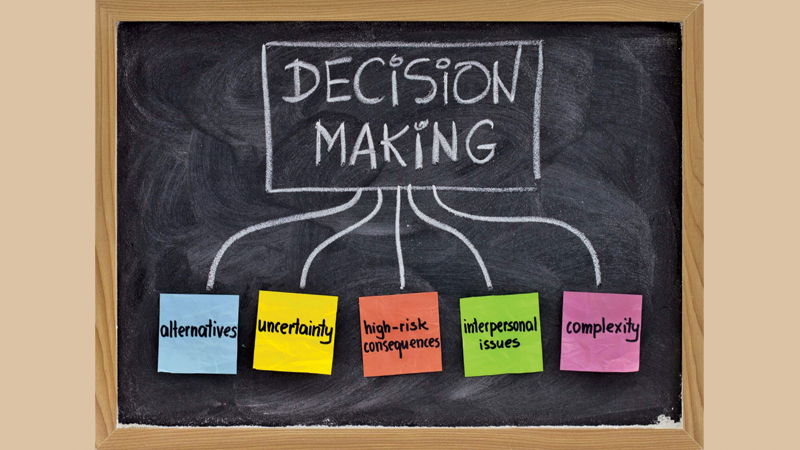 Business decision-making is not a single function. It is a process that involves several important steps with a scientific framework. Also, decision-making in business is one of the most crucial aspects in business that may lead to the success or failure of an organisation.
Business decision-making is not a single function. It is a process that involves several important steps with a scientific framework. Also, decision-making in business is one of the most crucial aspects in business that may lead to the success or failure of an organisation.
Hence, every business, small or big must go through this process cautiously before acting on business matters. Business decisions cannot and should not be made instinctively, even when managers are experienced, as the process opens doors for alternative perspectives and diverse ways of thinking.
Individuals make many instant and instinctive decisions every day on personal matters where the risk factor is comparatively low and can be adjusted or reversed if required. However, in business, when a decision is made, it can impact positively and negatively on many internal and external stakeholders and can have a lasting impact. A single wrong decision can lead to legal, financial or operational consequences that may result in revenue losses or damage the organisation’s image. Similarly, a wise and calculated decision can hugely influence business opportunities.
Structured approach
The decision-making process is systematic and follows a structured approach to achieve the best outcomes. Recognising the problem and identifying it clearly is the first step. The problem customarily is either about a business-related issue, an opportunity that can be utilised, or anything in between.
The problems could be revenue-related, administrative, or operational inefficiencies, while opportunities may be market- or customer-related. Decision makers, therefore, must ensure that the problem is carefully analysed, clearly defined, and everyone involved in the outcome agrees on what needs to be solved. This identifying process can provide enhanced outcomes as the key decisions are based on authentic information.
Once a problem or opportunity is identified, businesses must collect relevant data to understand the situation thoroughly. This data can be obtained from various sources such as market research, financial reports, customer feedback, and competitor analysis. Effective data analysis helps in identifying trends, forecasting outcomes, and assessing risks associated with different options.
Information is a critical component that provides the foundation to make an effective decision. Gathered information and data, give a better opportunity to select the best course of action. In a professional context, decisions made on accurate and relevant information minimise unpredicted risks.
While information gathering is essential to making business decisions, it may pose challenges in some instances. Hence, managers must be conscious of possible information overloads that may confuse the actual issue. Also, gathering information can be a time-consuming affair that can delay decision-making and adversely affect the business.
Instinct and creativity
Analysing available alternatives is another important step in the decision-making process. Rushing to adopt the first feasible solution is not advisable for employees. Identifying available courses of action may not always be apparent and decision-makers must employ their instinct and creativity to recognise and relate them. Having a reasonably wide range of alternatives grants managers more freedom in their choices.
Decision-makers go through a process of evaluating their options to find a solution to an issue based on available information. With the information at hand, they weigh the pros and cons to arrive at the most effective option. Alternatives help employees to identify the best solution to the issue on one hand, and they have a backup plan with remaining substitutions if the first action goes awry.
Selecting the best course of action involves multiple alternatives found by employees when a decision is about to be made. They need to keep the alternatives in hand while considering the constraints. Developing alternatives is a creative process that necessitates imagination and experience. Organisations must ensure thorough consideration of the best alternatives before finalising a course of action.
Choosing the most appropriate alternative can be done in several ways. The decision-maker can choose an option based on their professional experience. They can also choose an option to experiment and observe the result, although this action may cause disruptions. Finally, they can do a thorough analysis with available information about each alternative and make a rational decision. This option, however, can be time-consuming, which may lead to aggravation of the issue.
In any case, the decision should be based on logical reasoning, practical data, and tactical alignment with business objectives. However, in some cases, decision-makers might have to rely on their intuition and experience, especially when dealing with unpredictable market conditions.
Effectively communicated
Implementing the chosen alternative is where all factors discussed above move to reality. Analysis of the previous steps must be collectively utilised to implement the decision made. Once a decision is made, it must be effectively communicated and implemented. This requires careful planning, resource allocation, and stakeholder engagement. Employees and other relevant parties should be informed about their roles in executing the decision, and adequate support must be provided to facilitate a smooth transition.
The final stage of the decision-making process is to track and assess the outcome of the decision made. If the decision is effective and given a favourable end result, it can be added to the experience of the decision-maker, as a victory.
However, if a decision has gone wrong, the organisation can take corrective action as required. The intellectuals down the line have created a multi-step process to minimise decision-making errors and mistakes and provide successful results. This means that if the decision is made by going through these steps carefully, the margin for error is minimal.
Several factors influence the decision-making process in business. These include internal factors, such as organisational culture and resources, and external factors, such as market conditions and regulatory environments. In hierarchical organisations, decisions most often are taken by top management, while those with a collaborative culture with lateral management structures encourage decision-making at all levels.
External factors such as market trends, customer behaviour changes, unexpected economic crises, and competitor activities can also influence business decisions. Similarly, ethical consideration to balance profitability with social responsibility can have an impact on the process. The regulatory environment of the country can also be a factor in decision-making, where non-compliance can lead to legal situations.
Although the decision-making process provides strong guidance to operate a business with effective actions, businesses are invariably compelled to mitigate challenges. The omnipresent uncertainties and risks can produce negative results time and again, even when the decisions are made cautiously. Hence, studying and evaluating potential risks is essentially important while engaged in the process of decision-making.
The current flow of information through cyberspace can lead to information overload that can negatively influence decision-makers. Although information is vital in the process of analysing issues, too much of it can impact final decisions. Similarly, implementation can be rough if the stakeholders produce resistance to a decision. Overcoming this resistance requires effective communication, leadership, and change management strategies.
Systematic approach
The business decision-making process is a critically important function in any business that ensures a systematic approach to vital issues in an organisation. Effective decisions by all levels of employees help manage risks, maximise opportunities, lower costs, and manage waste, among many other benefits.
A well-structured decision-making process enhances overall efficiency, aligns actions with the organisation’s goals, and fosters a pragmatic and swift approach to both challenges and opportunities.
By carefully weighing the consequences and favouring positive results, organisations can protect against potential losses and achieve sustained growth. It also produces accountability, adaptability, and employee engagement to thrive in today’s competitive business landscape.







